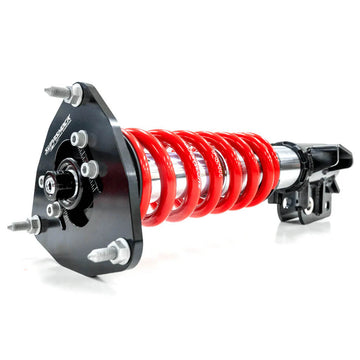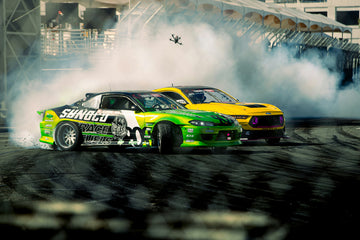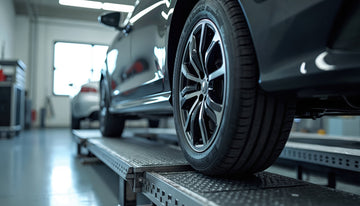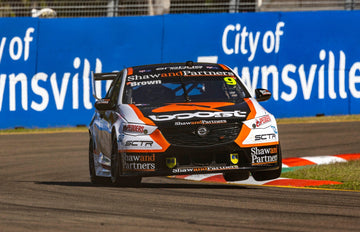Red Bull Ampol Racing make their presence known on the track with the Chevrolet Camaro – specifically Gen3 Chevrolet Camaros.
Like all Supercars, they have the following suspension set up:
- Front - The Macpherson strut with a single telescopic shock absorber, mounted inside a coil spring, and a lower control arm.
- Rear - Multi-Link suspension with multiple control arms and links, along with coil springs and shock absorbers.
The suspension system of a racing car consists of shock absorbers, springs, sway bars, and other interconnected components that collaborate to deliver optimal track performance and handling.
The double wishbone suspension, a type of multi-link suspension design, significantly contributes to the stability and handling of vehicles at high speeds. This advanced suspension system allows for optimal geometry settings which enhance the vehicle's cornering capabilities, grip, and overall stability; whether on a straightaway or navigating tight corners.
Throughout the racing season, the team collaborates closely with their technical partners to continuously develop and fine-tune their suspension setup. This ongoing refinement process enables them to make adjustments to the suspension settings during pit stops or between races, taking into account the specific track conditions and valuable feedback from the driver.
Glossary of terms
Strut Assembly
The strut or damper assembly is a through-shaft type and is a Supashock patented design. The strut assembly consists of the damper, the spring, upper and lower mounts, and other components.
Coil Spring
The coil spring is a helical spring that provides support and helps absorb impacts from the road surface. It is positioned around the shock absorber and serves to support the weight of the vehicle while allowing for vertical movement of the suspension. The coil spring assists in maintaining tire contact with the road and helps to smooth out the ride.
Lower Control Arm
The lower control arm connects the wheel assembly to the vehicle's chassis. In the double wishbone suspension system, there are two lower control arms, each attached to the chassis at one end and the wheel assembly at the other. These control arms are instrumental in providing support, stability, and precise control over the vertical and lateral movement of the wheel. By effectively managing these movements, the lower control arms contribute significantly to maintaining optimal alignment and geometry of the suspension.
Shock Absorbers
Shock absorbers, also called dampers, are hydro-pneumatic devices that work in conjunction with the coil springs. They help control the movement of the suspension and dampen the oscillations caused by road disturbances. Shock absorbers use hydraulic fluid and pistons to absorb the kinetic energy generated by the suspension movement and dissipate it as heat. This process helps stabilise the vehicle and provide a smoother and more controlled ride.
Links
In addition to control arms, suspensions incorporate various links that connect the control arms and other suspension components. These links, such as lateral links, trailing links, and toe links, play a crucial role in defining the range of motion and controlling the suspension's behaviour under different driving conditions.
Why do Red Bull Ampol Racing cars need advanced suspension?
Enhanced Handling
Advanced suspension systems allow for precise control and responsiveness, enabling the driver to effectively navigate corners, maintain traction, and make quick manoeuvres. The suspension geometry, damping characteristics, and adjustability of advanced systems contribute to improved handling and stability, crucial for racing at high speeds.
Optimal Weight Transfer
During acceleration, braking, and cornering, weight transfer occurs, affecting the distribution of force among the tires. Advanced suspension systems can efficiently manage weight transfer, ensuring optimal tire contact with the road surface. This maximises grip, enhances traction, and helps maintain control and stability, allowing the driver to extract the best performance from the vehicle.
Customisation and Tuning
Advanced suspension systems often feature adjustable components such as dampers, springs, and anti-roll bars. This allows the racing team to fine-tune the suspension setup to suit different track conditions, driver preferences, and racing strategies. The ability to optimise the suspension for specific scenarios enhances the car's performance and competitiveness.
Improved Ride Control
Racing cars experience high-speed vibrations and impacts on the track. Advanced suspension systems, with their specialised damping characteristics and responsiveness, help absorb and dissipate these vibrations more effectively. This results in better ride control, reduced body roll, and improved stability, allowing the driver to maintain a consistent and predictable line on the track.
Durability and Reliability
Racing cars endure extreme conditions and loads during races. Advanced suspension systems are designed to withstand these demanding circumstances, providing durability and reliability to endure prolonged periods of high-performance driving.





